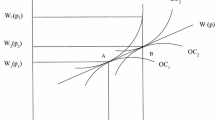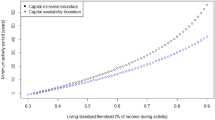Abstract
Discount rate plays a very important role in cost–benefit analysis of environmental, health and occupational safety policies. Since resources are limited, valuing the future benefits at present value using a discount rate becomes necessary for a government to decide on worthiness of any project. In this context, the choice of discount rate is a debated issue, especially for developing countries where such studies are scarce. The present study attempts to address this issue by estimating the discount rate for long-term job-related health risks of a sample of workers from an Indian city, Ahmedabad. These job risks pertain to environmental health risks and unhealthy work conditions. In this study, an extension of the standard hedonic wage method is used which captures the inter-temporal aspect of worker’s decision on choice of job risk and thereby reveals their implicit rate of time preference. The estimated discount rate for this study ranges between 2.6 and 18.6%. These estimates are consistent with the estimates of developed and developing countries. The corresponding value of statistical life ranges between INR 46.3 million ($0.69 million) and INR 81.28 million ($1.21 million). The discount rates calculated in this work will benefit policymakers in India and other developing countries in evaluating and designing various policies.

Source: Moore and Viscusi (1990a)
Similar content being viewed by others
Notes
The social rate of time preference “s” is expressed as, \(s = \mu g + \tau\), where “\(\tau\)” is rate of pure time preference which indicates the myopic nature of individuals in society, “g” is the growth rate of per capita real consumption, and “\(\mu\)” is the elasticity of marginal utility of consumption (Markandya and Pearce 1988).
For this study, the scale of fatality rate is taken per 0.1 million and the scale of injury rate is taken per 1000 workers. Using the number of deaths and injuries in factories of Gujarat and corresponding employment during 2010–2014, the fatality rate per 0.1 million worker and the injury rate per 1000 workers have been estimated. The following formula has been used to calculate the probability of death per 0.1 million worker for a particular year. Thus, the average probability of death (i.e. fatality rate) in this study is calculated using 5 years data\({\text{Probability}}\; {\text{of}}\; {\text{death}} = \frac{{{\text{Total}}\;{\text{ number}}\; {\text{of}}\;{\text{ fatal}}\; {\text{injuries}}\;{\text{ for}}\;{\text{ a}}\;{\text{ NIC}} }}{{{\text{Total}}\; {\text{number }}\;{\text{of }}\;{\text{blue }}\;{\text{collar}}\;{\text{ workers }}\;{\text{for}}\;{\text{ a}} \;{\text{NIC}} }} \times \left( {100,000} \right)\)
The probability of injury per one thousand workers for a particular year has been calculated by the following formula. Similarly, the average probability of injury (i.e., injury rate) in this study is calculated using 5 years data\({\text{Probability}}\;{\text{ of}}\;{\text{ injury}} = \frac{{{\text{Total}}\;{\text{ number}}\;{\text{ of}}\;{\text{ non}}\;{\text{ fatal}}\;{\text{ injuries}}\;{\text{ for}}\;{\text{ a}}\;{\text{ NIC}} }}{{{\text{Total}}\;{\text{ number }}\;{\text{of}}\;{\text{ blue}}\;{\text{ collar}}\;{\text{ workers}}\;{\text{ for}}\;{\text{ a}}\;{\text{ NIC}}}} \times \left( {1000} \right)\)
Value of Statistical Life from specification 1 = co-efficient of ELYL variable from specification 1 × mean wage × annual hours of work × 100,000 = 0.006 × 42.96 × 2160 × 100,000 = INR 55.6 million ($0.83 million).
Value of Statistical Life from specification 2 = co-efficient of ELYL variable from specification 2 × mean wage × annual hours of work × 100,000 = 0.005 × 42.96 × 2160 × 100,000 = INR 46.3 million ($0.69 million).
Value of Statistical Injury from specification 1 = [co-efficient of injury variable + (co-efficient of compensation variable × mean compensation benefit) × mean wage of the sample] × annual work hours × 1000 = [(0.051 − (0.040 × 0.46)) × 42.96 × 2160 × 1000] = INR 1.29 million ($0.019 million).
Value of Statistical Injury from specification 2 = [co-efficient of injury variable + (co-efficient of compensation variable × mean compensation benefit) × mean wage of the sample] × annual work hours × 1000 = [(0.052 − (0.045 × 0.46)) × 42.96 × 2160 × 1000] = INR 2.90 million ($0.043 million).
References
Becker, G. 1964. Human Capital, a Theoretical and Empirical Analysis with Special Reference to Education. New York: Columbia University Press.
Becker, G.S., and M.B. Casey. 1997. The Endogenous Determination of Time Preference. Quarterly Journal of Economics 112 (3): 729–758.
Bickel, W., A. Odum, and G. Madden. 1999. Impulsivity and Cigarette Smoking: Delay Discounting in Current, Never, and Exsmokers. Sychopharmacology 146 (4): 447–454.
Borghans, L., and B. Golsteyn. 2006. Time Discounting and the Body Mass Index, Evidence from the Netherlands. Economics and Human Biology 4 (1): 39–61.
Della, V.S., and D. Paserman. 2005. Job Search and Impatience. Journal of Labor Economics 23 (2): 527–588.
Fuchs, V.R. 1982. Time Preference and Health: An Exploratory Study. In Economic Aspects of Health, 93–120. Chicago: University of Chicago Press.
Garen, J.E. 1988. Compensating Wage Differentials and Endogeneity of Job Riskiness. The Review of Economics and Statistics 7 (1): 9–16.
Golsteyn, B.H., Grönqvist, H., and Lindahl, L. 2013. Time Preferences and Lifetime Outcomes. Discussion Paper No. 7165, IZA Institute of Labour Economics.
Grossman, M. 1972. On the Concept of Health Capital and the Demand for Health. Journal of Political Economy 80 (2): 223–255.
Kula, E. 2004. Estimation of a Social Rate of Interest for India. Journal of Agricultural Economics 55 (1): 91–99.
Lawless, L.J., Nayga, R., and Drichoutis, A. 2013. Time Preference and Health Behaviour: A review. Munich Personal RePEc Archive (MPRA) (Paper No. 45382). http://mpra.ub.uni-muenchen.de/45382/. Accessed 11 Dec 2018.
Markandya, A., and Pearce, D.W. 1988, Environmental Considerations and the Choice of the Discount Rate in Developing Countries, Environment Department Working Paper 3, World Bank, Washington, DC
Mincer, J. 1958. Investment in Human Capital and Personal Income Distribution. Journal of Political Economy 66 (4): 281–302.
Moore, M., and W.K. Viscusi. 1988. The Quantity-Adjusted Value of Life. Economic Inquiry 26 (3): 369–388.
Moore, M., and W.K. Viscusi. 1990a. Discounting Environmental Health Risks: New Evidence and Policy Implications. Journal of Environmental Economics and Management 18 (2): S51–S62.
Moore, M., and W.K. Viscusi. 1990b. Models for Estimating Discount Rates for Long-Term Health Risks Using Labor Market. Journal of Risk and Uncertainty 3 (4): 381–401.
Pender, J.L. 1996. Discount Rates and Credit Markets: Theory and Evidence from Rural India. Journal of Development Economics 50 (2): 257–296.
Reserve Bank of India. 2017. Results of the Survey of Professional Forecasters on Macroeconomic Indicators: Round 44. https://rbi.org.in/Scripts/PublicationsView.aspx?id=17433. Accessed 6 Feb 2019.
Shanmugam, K.R. 2006. Rate of Time Preference and the Quantity Adjusted Value of Life in India. Environment and Development Economics 11 (5): 569–583.
Shanmugam, K.R. 2011. Discount Rate for Health Benefits and the Value of Life in India. Economics Research International 2011: 1–5.
Stephens, M., and Krupka, E. 2006. Subjective Discount Rates and Household Behavior. Working paper, Department of Economics, University of Michigan.
Thaler, R., and Rosen, S. 1976. The Value of Saving a Life: Evidence from the Labor Market. In N. E. Terleckyj, Household Production and Consumption (pp. 265–302). NBER.
Viscusi, W.K. 1979. Employment Hazards: An Investigation of Market Performance. Cambridge: Harvard University Press.
Viscusi, W.K. 1995. Discounting Health Effects for Medical Decisions, Valuing Healthcare. In Valuing Health Care Costs, Benefits, and Effectiveness of Pharmaceuticals and Other Medical Technologies, ed. S.A. Frank, 125–147. Cambridge University Press.
Viscusi, W.K., and M.J. Moore. 1989. Rate of Time Preference and Valuations of the Duration of Life. The Journal of Public Economics 38: 297–317.
Zhuang, Z.L., Lin, T. and De Guzman, F. 2007. Theory and Practice in the Choice of Social Discount Rate for Cost-Benefit Analysis: A Survey. Asian Development Bank, Economic and Research Department Working Paper Series, Working Paper No. 94.
Funding
This research has received no grant from any funding agency or organization.
Author information
Authors and Affiliations
Corresponding author
Ethics declarations
Conflict of interest
On behalf of my co-author, I declare that we do not have any conflict of interest with any person or any institution.
Additional information
Publisher's Note
Springer Nature remains neutral with regard to jurisdictional claims in published maps and institutional affiliations.
Rights and permissions
Springer Nature or its licensor (e.g. a society or other partner) holds exclusive rights to this article under a publishing agreement with the author(s) or other rightsholder(s); author self-archiving of the accepted manuscript version of this article is solely governed by the terms of such publishing agreement and applicable law.
About this article
Cite this article
Majumder, A., Madheswaran, S. Discounting Long-Term Job-Related Health Risks in the Context of Indian Workers. Ind. J. Labour Econ. 65, 1099–1120 (2022). https://doi.org/10.1007/s41027-022-00415-4
Accepted:
Published:
Issue Date:
DOI: https://doi.org/10.1007/s41027-022-00415-4
Keywords
- Job-related health risks
- Discount rate
- Rate of time preference
- Expected life years
- Life cycle
- Value of statistical life




